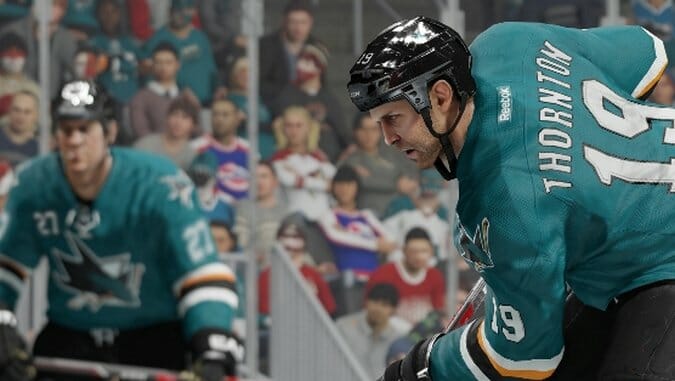NHL 15 (Multi-Platform)

I’m an admirer of the NHL games from afar. Growing up in the American South, the terminal swamp of the United States, I never experienced hockey as a youth. Football and baseball dominated the “forced into team sports” days of my elementary and middle school education, and the former was the only sport deemed worth watching on television as I was growing up. I spent a few weeks with a bargain-bin NHL 2000 on a Playstation one teenage summer. I spent a solid week of confused, angry cursing and drafting with NHL 2011 when I was laid up with illness earlier this year. Despite never picking up the rules in “real life” or my stints playing these previous games, I decided that I really wanted to give NHL 15 a serious, good-faith effort, with minimal cursing and confusion.
The short version is that it didn’t work.
There’s a long-standing argument in both video- and board- games culture about complexity and how much of your time and energy you should give to a game before flipping a table or putting down a controller. Sometimes this is explained in patronizing artistic terms: “If you really put in the sufficient time, then you would understand how brilliant this is.” Sometimes it is laid out in the classic hardcore vs. casual gamers frame: “The game opens up when you develop a required bare minimum skill to access its complexity.” In both of those contexts, there is the feeling that you need to wholly give yourself over to something in order to really grasp its beauty. To love the machine as much as you should, we are told, you must turn into that machine.
This is a spectrum. How much you have to give yourself over to the machine with any given game plots that game’s location on that spectrum. Playing Tag requires very little buy-in from the player. You agree that you’re playing and you use your already-existing faculties to play. Playing Dwarf Fortress requires a massive amount of adaptation of your mind and body. You change the way you interact with your computer, the visual language of games, and your relationship with text in games. Getting to the place where you feel like Dwarf Fortress is actually giving you something wonderful and fulfilling takes days or weeks. Like all discipline, it is uncomfortable and frustrating.
NHL 15 does nothing to explain how the game works to you. The main menu is divided into three tabs. The Home screen offers you a “quick play” of your most played mode, a list of alerts and news about the game, a provocation to play new game modes, and a button where you can watch a trailer for the game you are playing. Other tabs include Play and Customize. The former is a container to play the various modes—quick play, online play, the ultimate hockey mode, playoffs, general manager simulation, pro player simulation, practice mode, and a replay editor. The latter allows you to edit rosters, choose your favorite team (which seems arbitrary as far as I can tell), enter product codes, and change your game settings.
These are all delivered to the player at one time without any weighting about what game modes are best for new or older players. A full half of my experience with the game has been about fumbling around in the dark when it comes to both menus and the actual activity of playing the sport of hockey. I want to contextualize this by reminding the reader that I have played hockey games before. And yet still this game presents itself to me as needlessly obscure, opaque, and difficult to orient myself toward.
From my attempt at playing this game, being a general manager is less about managing a team and more about hitting the “simulate until this game” button after placing agents around the globe in a management experience with as much depth as an Assassin’s Creed game. My time as Monster Mash, the Detroit Redwings GM, did not last long, both out of boredom and a lingering question about what I was actually supposed to be doing.







































